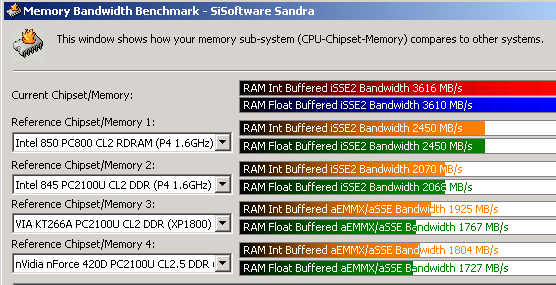Unstoppable: DDR400 vs. Rambus
Conclusion: DDR400 Outperforms RDRAM (PC800) - Much Depends On The Chipset
Out tests with hand-picked memory modules ranging from DDR400 to RDRAM (PC1200) show that, with an identical system configuration, a performance boost of almost 50% is possible. Note here that this is in combination with the same processor. While DDR200 brings up the rear of the performance ranks, RDRAM with 533 MHz and 600 MHz reach the top performance levels.
A special topic is the further development of DDR memory: currently, only DDR333 modules with CL2.5 for 166 MHz memory clock are available. In most cases, these modules are not faster than DDR266 with CL2. A distinct increase in speed is offered by DDR333, but only in the CL2 version. DDR400 memory is only at its starting phase - the first of these modules will probably be available with a CAS latency of 3, followed by modules with CL2.5. We were pleasantly surprised by a new chipset, which will officially be launched at the end of May. The manufacturer has optimized the memory interface of the new chipsets, so that the future chipset impressed us in the memory tests. In all of the benchmarks, the combination of the new chipset with DDR333 outperformed Intel 850 with RDRAM and 400 MHz memory clock. Nevertheless, RDRAM with 533 MHz (PC1066) still sets the performance standard, even DDR400 is not quite able to reach the same performance level.

The results of the SiSoft Sandra 2002 Memory Benchmark speak for themselves.
At the moment, the price for Rambus memory is quite inexpensive, so it's worthwhile to consider buying or putting together the corresponding systems. Rambus still has a right to claim a share of the market, which is evidenced by the fact that numerous motherboard manufacturers, such as Asus, Aopen, Biostar, MSI and Iwill, will soon be coming out with boards that support RDRAM. The reason for this is that in many stores, a PC800 module costs less than DDR333 memory with CL2. However, this development should not be overestimated.
Stay on the Cutting Edge
Join the experts who read Tom's Hardware for the inside track on enthusiast PC tech news — and have for over 25 years. We'll send breaking news and in-depth reviews of CPUs, GPUs, AI, maker hardware and more straight to your inbox.
Current page: Conclusion: DDR400 Outperforms RDRAM (PC800) - Much Depends On The Chipset
Prev Page Overview Of Memory Modules, Continued